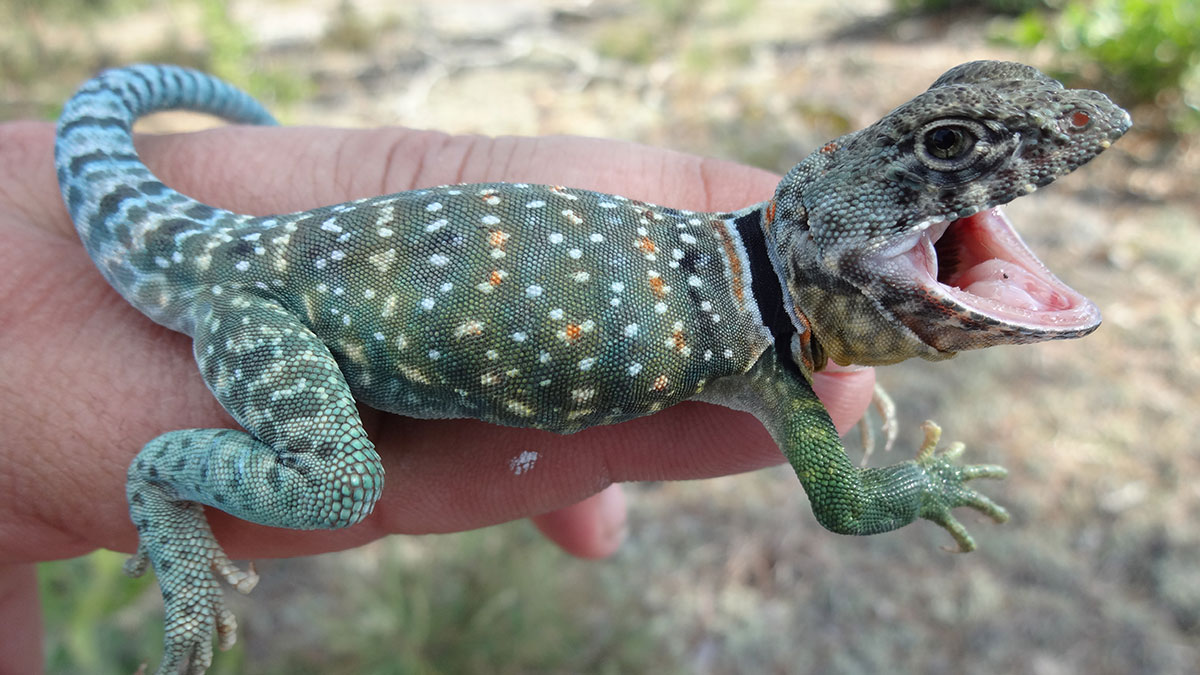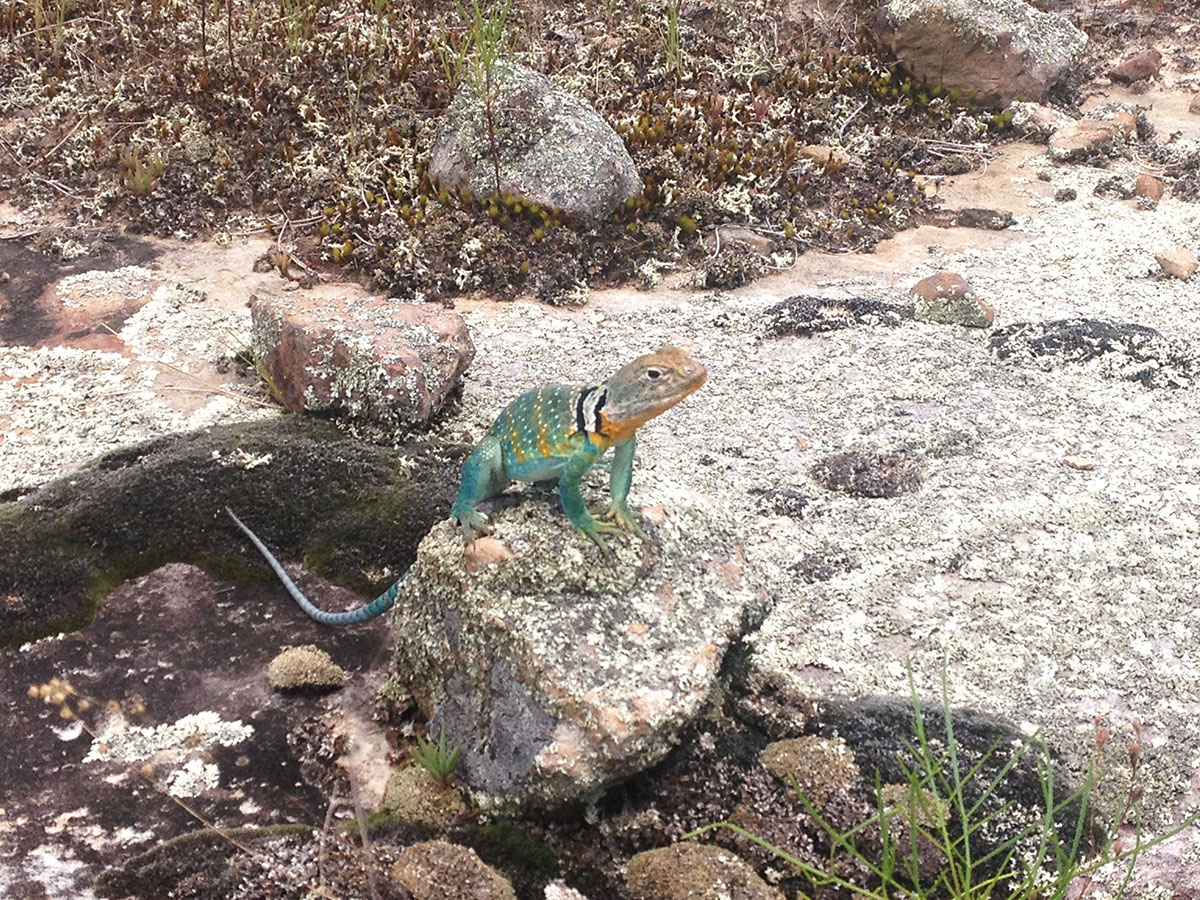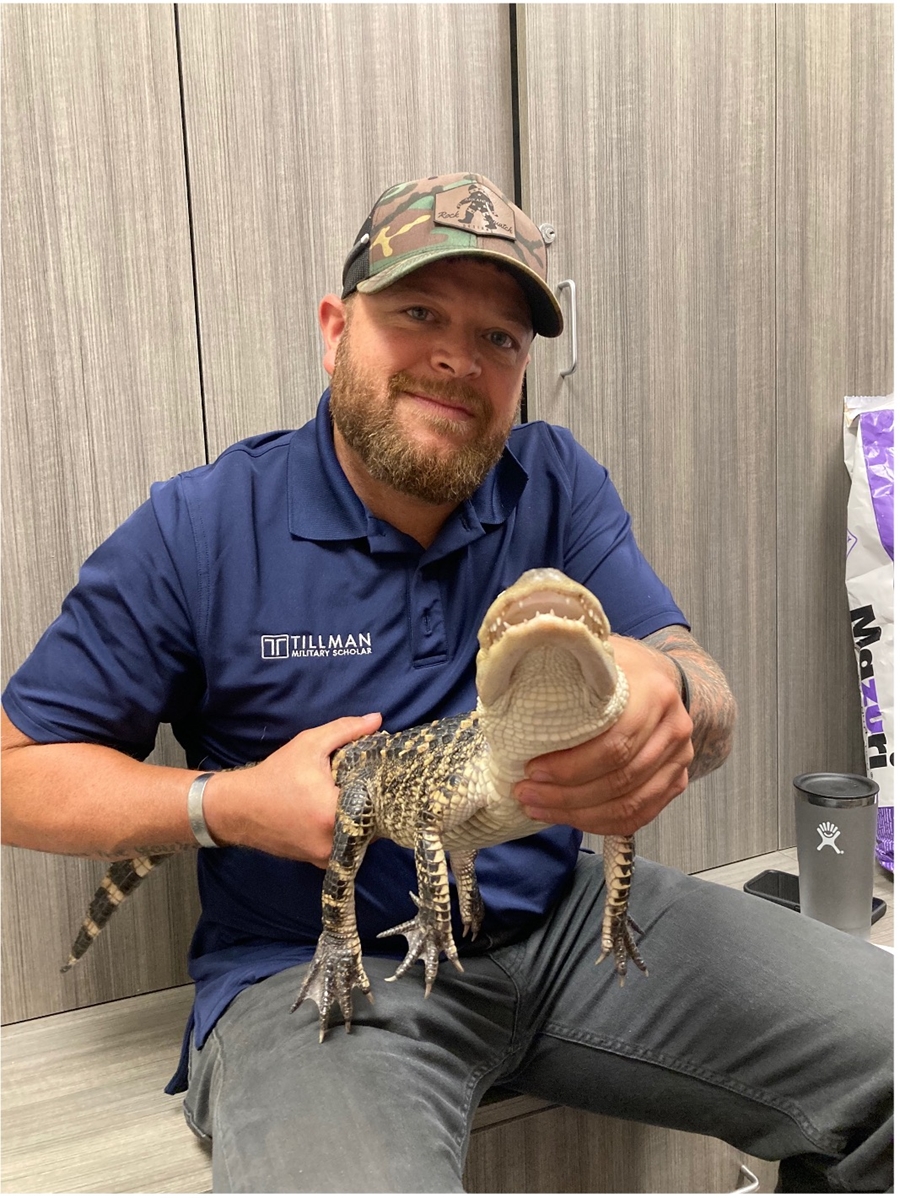Biologist Collaborating With Game and Fish, Other Agencies, to Restore Glades
University of Arkansas biologist Casey Brewster, who catches lizards with a fishing pole, is working with several agencies, including the Arkansas Game and Fish Commission and the U.S. Forest Service, to conserve and restore a critical habitat in the Ozarks.
Brewster, a post-doctoral fellow in the laboratory of biological sciences professors Marlis and Michael Douglas, understands the impact of forest encroachment on glades — the rocky, semi-arid patches of ground found within large swaths of forested woodlands.
THE EASTERN COLLARED
In the December issue of The American Naturalist, a publication of the University of Chicago Press, Brewster, who also teaches biology at NorthWest Arkansas Community College, published findings from a five-year field study of the eastern collared lizard population in the Ozark Mountains of northern Arkansas.
As with most small lizards, the eastern collared lizard is quick and runs extremely fast. It's like a dragster, its rear-end torque and acceleration sometimes too powerful for the rest of its body, causing it to lift up and run on two legs.
Brewster used thermal ecology modeling and conservation physiology to study to the impact of encroaching forests on the Ozark glades and the habitat of the eastern collared. His study showed that the lizard's population has declined as forests have grown denser.
The lizards need sunlight for basking. This helps them warm up so they can hunt.
 An eastern collared lizard on a broken chunk of stone. Photos by Casey Brewster. |
 A close-up of the eastern collared lizard. |
 An eastern collared lizard stands on a lichen-covered rocky glade. |
"Forest encroachment has created more shade," Brewster said. "That part is clear. But trees and shade don't kill lizards — it's not that simple. Though more shade means fewer healthy, happy lizards, it remains unclear what factors specifically are causing this decline."
Because of the increased shade, Brewster found, the Eastern Collared cannot begin its normal daily routine as early in the morning. The sun must be higher to shine on open glade spots, forcing lizards to "sleep in" in the morning and go to bed early in the evening. Doesn't seem like an altogether bad life, but this shorter day causes problems. It means the Eastern Collared spends more time hidden under rocks where temperatures are cold.
This causes other problems.
"Less sun to bask in gives these lizards digestion problems," Brewster said. "Higher temperatures are more suitable for digestive processing. If they can't absorb their food, they have less energy to grow and reproduce. These factors combined appear to cause the lizard populations to be weaker and less successful."
WHAT'S A GLADE?
If you've done even a moderate amount of hiking in the Ozarks, there's a good chance you've encountered a glade or possibly trekked across one without knowing what it is. Neither forest nor prairie, glades are open areas with lots of exposed bedrock and minimal topsoil, the perfect environment for a sunbathing lizard.
Typically found on the slope of a hill or somewhere near the top of a ridge, glades are drier than forests, but that does not mean they lack plants and other organisms. In fact, glades are "hotspots of biodiversity," as one of Brewster's colleagues puts it. They are unique ecosystems with many types of insects, animals and plants, the latter of which tend to be heartier because of the harsh environment. If you're walking in an area with lots of coreopsis, coneflower and prickly pear, you're probably in a glade.
So why are they are they shrinking? Trees, especially red cedar, which sometimes seems to grow right out of bedrock, have slowly spread across glades, in part because of land-management decisions made years ago. Natural fire suppression has helped the forests expand.
RESTORATION COLLABORATION
But this is changing. Brewster hopes to learn more about what's going on with the eastern collared by participating in a large collaborative project to restore glade habitat in the Ozarks. This conservation effort also includes contributions from the Arkansas Game and Fish Commission, The Nature Conservancy, Little Rock Zoo and the U.S. Forest Service.
Through limited, prescribed burns and strategic harvesting of red cedars, Brewster and partners at these agencies have curtailed forest encroachment and restored some ground flora, including rare wildflowers, within glades. The flowers act as pollinators, which attract more insects, which in turn attract lizards.
"There's still a lot of work to be done before we are able to truly reverse the trend on eastern collared lizard populations in the Ozarks," Brewster said. "But, with the continued support and efforts by the many people and agencies focused on conservation of this species and Ozark glades, things appear to be heading in the right direction."
To learn more about this project, see what a glade looks like and watch Brewster catch an eastern collared lizard, check out this short video.
 An Ozark glade near Sneeds Creek in the Ponca Wilderness of the Buffalo National River. Photo by Charlie Alison.
An Ozark glade near Sneeds Creek in the Ponca Wilderness of the Buffalo National River. Photo by Charlie Alison.
Topics
Contacts
Casey Brewster, post-doctoral fellow
Department of Biological Sciences
240-377-1752,
clbrewst@uark.edu
Matt McGowan, science and research communications officer
University Relations
479-575-4246,
dmcgowa@uark.edu
Headlines
Four Students Named Goldwater Scholars; Two Earn Udall Honorable Mentions
Four U of A students have received the prestigious Goldwater Scholarship, an award for top students in mathematics, science, and engineering.
Cross-Campus Collaboration Culminates in New Outdoor Geological Installation
Grand opening event to celebrate the new GeoLab installation at the U of A’s Gearhart Hall courtyard is set for May 3. The installation will be open to the public year-round.
First Students to Use Online Degree to Hone Nursing Leadership, Elevate Patient Care
Hanna Baxendale and Wendi Kimbrell will begin coursework in the Doctor of Nursing Practice-Executive Master of Business Administration program offered by the Eleanor Mann School of Nursing and Walton College.
Join the Office for Sustainability on a Final Cruise to Campus
Cruise to Campus Wednesdays have fostered a gathering space for individuals interested in biking to campus. Drop by the Old Main Lawn from 7:30-10 a.m. Wednesday for coffee, something to eat and conversation.
Fay Jones School Student Ambassador Program Gives Voice to Design Students
The student ambassador program at the Fay Jones School of Architecture and Design is built to connect top design students with their school, its alumni, its future students and others inside and outside the school.





